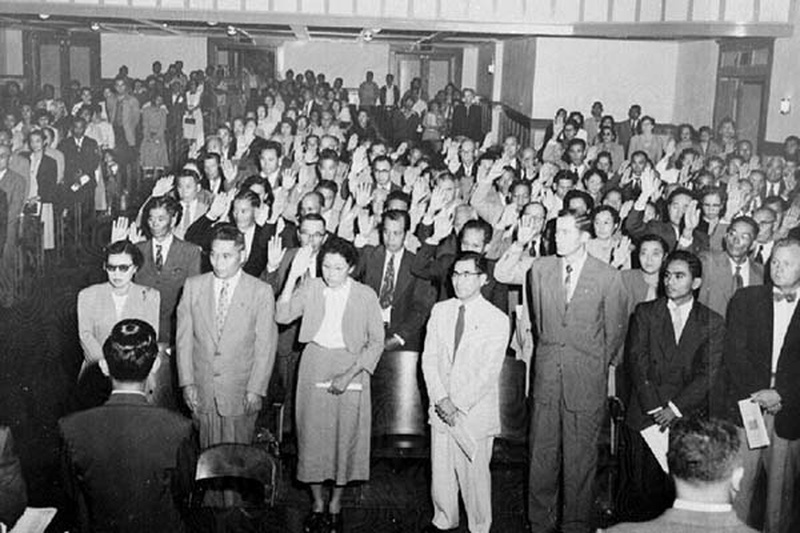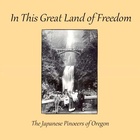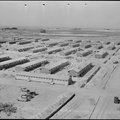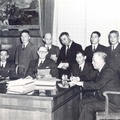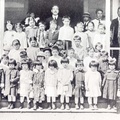Once he was our friend
The owner of the store now
Behaves nervously
Refusing to sell us goodsShizue Iwatsuki1
With the war coming to an end, Oregon experienced renewed anti-Japanese movements. In Gresham, local farmers and businessmen, inspired by the economic advantage of Japanese exclusion, started a campaign to prevent their return as early as 1943. This movement led to the establishment of the Oregon Anti-Japanese Inc., in November, 1944. Later renamed the Japanese Exclusion League, this group called for “the enactment of legislation, both State and Federal, designed to exclude from United States citizenship now ineligible for citizenship, as well as their descendants.”2
Hood River also had an exclusionist movement. As in the first organized agitation, the local American Legion took the lead. The argument against the return of the Japanese were essentially the same as before: their low standards of living, unassimilability to American society and economic threat. The Legion published the pamphlet entitled “A Statement on the Japanese.” It read:
Through the years we have seen, not the Americanization of the Japanese here, but the rapid and sure Japanization of our little valley…The carefully organized infiltration of cohesive alien groups, the carefully organized evasion of the alien land laws, the deliberate alienation of children, and finally the full realization that we are faced with alternatives of abandoning our homes to an alien people or of finding lawful means to disperse these aliens.3
In December, 1944, the Legion removed the names of 16 Nisei servicemen, including Sgt. Frank Hachiya, from public honor roll. This action drew a storm of criticism from the entire nation, and under the increasing pressure, the names were reinstated to the roll the following April.
However, the Hood River American Legion held to its position against Japanese resettlement by setting up an independent organization called the Hood River Citizens Committee4. Between January and March, 1945, one of the Legion leaders ran full page ads in a local newspaper with the names of over 1,500 local residents who assisted “one hundred percent in all efforts to keep the Japs from returning to this county.” With captions such as ‘JAPS ARE NOT WANTED IN HOOD RIVER,” the ads not only publicized the doctrine of the Legion, but also attacked anyone who was supportive of Japanese resettlement.5
One of the few supporters of the Japanese was the local Methodist minister, Sherman Burgoyne. Assigned to the church of Hood River during the war, he had never met any of the Japanese, but, for the principles involved, he stood up for their rights and openly acted as their friend. One of the exclusionist ads called the minister a pro-Japanese and criticized him for failing to “get a true picture of the sentiment in the country”.6 The effect of the attack was so great that he faced ostracism from the white community and his wife was fired by a local bank. Reverend Burgoyne received the Thomas Jefferson Award from the Council Against Intolerance in 1947, and overt social intolerance began to lessen.7
Indeed, what awaited many Japanese Americans when they finally returned to their Oregon homes was intense antagonism. In Hood River, some of the earlier returnees were met at the station by local residents carrying anti-Japanese placards. Unable to get off the train, they had to sneak into town at night by car. Due to such extreme hostility, the WRA regularly dispatched FBI agents to protect the safety of the returnees in the valley. In their daily lives, both Issei and the Nisei received unfriendly, cold treatment by their old neighbors. Stores refused service to them and packing sheds did not accept their crops. The first Issei returnee recalls the days of anxiety: “[T]he town rejected us….We were caught in the fear that somebody might come to attack us, and we jumped even at the creaking of a door or at mice running on the ceiling at night.”8
The renewed anti-Japanese agitation discouraged many Japanese Americans from returning to Gresham and Hood River. In comparing the 1950 statistics of the Gresham-Troutdale Japanese farmers to the 1942 figures, there was more than a forty percent drop in the Japanese farming population.9 In Hood River, the local Japanese population before mass exclusion was 579: 184 Issei and 395 Nisei. Yet, by 1950 only 233 Japanese had returned to the Hood River Valley.10 Masuo Yasui, former community leader, was one of those who did not return after the war, although he still retained ownership of one orchard. Based on his arrest by the FBI and four-year incarceration in various Justice Department camps, local exclusionists contend that Yasui was “a traitor, a spy, and a dangerous enemy alien.”11 Given veiled threats of violence from former neighbors, he had to give up resettlement in the valley community and move to Portland where he could still see his beloved Mt. Hood from a distance.
In the eyes of the returning internees, Portland was the safest and most welcome place in western Oregon. In February, 1945, a coalition of religious leaders, educators and civil rights activists formed the Portland Citizens Committee and assisted the Japanese in finding housing and getting employment with union membership.12 The Oregon Congress of Industrial Organizations (CIO) also declared its full cooperation with Japanese resettlement and accused the exclusionists in Hood River and Gresham of “arousing racial prejudices for their own partisan ends.”13 Furthermore, under the auspices of the Oregon Methodist Church Conference, the Japanese Methodist Church building was opened to those who needed temporary shelter. Such a favorable climate induced many people to choose Portland as the place to start over. By 1946, a total of 463 Issei and 396 Nisei came back to the city.14
After the war, the Issei left community affairs to their children, primarily because of the devastating effects of mass internment and their age. Upon returning to Portland, Issei elders agreed that the local JACL should assume community leadership, and they did not form any central organization equivalent to the pre-war Japanese Association. Other communities like Gresham and Hood River had the Issei-led Nikkeijin-kai. However, they were, by and large, social clubs, and matters of community and political concerns were left in the hands of the Nisei.15
The notable exception was the Issei leadership in the struggle to overturn the alien land laws in the latter half of 1940s. In early 1945, the Oregon state legislature had passed the second Alien Land Law backed by the Hood River and Gresham exclusionists. The new law, a supplement to the 1923 statue, was extremely oppressive to the Issei because it even denied their right to live and work on farmlands. In addition to the ban on Japanese leasehold and land ownership, the laws had a provision which any such individual who “shall till, farm, or work land in the state or occupy the same in any capacity” is presumed as the “owner of a leasehold or some interest in land.” Hence, it could be a criminal offense for the Issei to simply work on somebody’s farm. Furthermore, a Nisei could be also prosecuted if it was established under the law that he/she entered a lease contract with the intention to have “aliens ineligible to citizenship” occupy or work on the land.16 Facing the risk of making their children “criminals,” the Issei had to stay away from their children’s farms.
In cooperation with the Portland JACL, the Issei fought the law. With Issei leader Daiichi Takeoka as the chairperson, they formed the Committee for the Oregon Alien Land Law Test Case in April, 1946. Learning that the Multnomah County Bar Association was critically looking into the 1945 statue from a legal standpoint, the committee decided to work with Bar Association and hired its president Verne Dusenbery and Allan Hart as their legal counsels. One year after the establishment of the Committee, a suit was filed at the Multnomah County Circuit Court on behalf of an Issei father and Nisei son who sought to lease a farm in Gresham.17
For the test case, the Committee chose Etsuo Namba, an Issei who had farmed in Gresham since 1917, and Kenji Namba a Nisei who fought in the 442nd Regimental Combat Team. In January and February of 1947, the Nambas negotiated with a landowner to lease 62 acres for five years. Although the Issei father and Nisei son had separate contracts, dividing the land in half, neither of the two leases could be executed unless the other was executed. The dwelling house was located in the west section of the land which Kenji was to lease. Under this arrangement, as the plaintiffs expected, the court was required to rule on both the Issei’s right to lease land and the constitutionality of the 1945 statute which prohibited the Issei from living with the Nisei on a leasehold.18
The court case continued for two years. In October, 1947, the Multnomah County Circuit Court fundamentally upheld the ban on leasehold by the Issei.19 The Japanese appealed the decision and brought their case before the Oregon State Supreme Court. On March 29, 1949, the Court reversed the previous decision and ruled that the laws violated the equal protection clause of the Fourteenth Amendment. The judge argued:
The several hundred alien Japanese to whom the Alien Land Law is applicable came to our state lawfully under the laws enacted by Congress. They are here lawfully and are entitled to remain. Many of them are parents of United States citizens, and some of them are mothers and fathers of American soldiers who gave a good account of themselves in the recent war. Our country cannot afford to create, by legislation or judicial construction, a ghetto for our ineligible aliens. And yet, if we deny to the alien who is lawfully here the normal means whereby he earns his livelihood, we thereby assign him to a lowered standard of living.20
This historic ruling not only voided the laws that had beset the Issei for many years, but also exemplified a significant change in Oregon. From exclusion to acceptance, the attitude of the dominant society was undergoing a dramatic transformation. Three years later, America repealed the legal status of the Issei as “aliens ineligible to citizenship.” The Walter-McCarran Act of 1952 allowed Japanese immigrants to become naturalized citizens of the United States, ending the long history of legal discrimination. Without question, the Issei had been “Americans” by their deeds and in their hearts, but their adopted country finally accepted them by including them in its founding principles of justice and equality. In a practical sense, it was much too late, for many Issei had already passed away and other were too old to start over. Nevertheless, it symbolically validated Issei life and their contributions to “this great land of freedom.”
Pounding rice cakes to celebrate
My American citizenship
Now I am so oldOba Sakyu21
Notes:
1. Kazuo Ito, Issei: A History of Japanese Immigrants in North America, p. 695.
2. The Oregonian, February 10, 1945; Marvin G. Pursinger, “Oregon’s Japanese in World War II, A History of Conpulsory Relocation,” pp. 390-398; and “The Japanese Problem in Oregon,” Oregon Law Review 24 (1945) 215-216.
3. Marvin G. Pursinger, “Oregon’s Japanese in World War II, A History of CompulsoryRelocation,” p. 353.
4. Ibid., PP. 353-366, 387.
5. Hood River, News, January 26, February 2, 9, 16, 23, and March 23, 1045.
6. Hood River, News, January 26, 1945.
7. Shiro Fujioka, Ayumi no Ato, pp. 635-636; Kazuo Ito, Issei: A History of Japanese Immigrants in North America, pp. 693-694. Sherman Burgoyne was selected as a winner of the award along with Eleanor Roosevelt and Frank Sinatra for his dedication to the advancement of democracy. Some 1000 organizations and 500 newspaper editors cast their votes in the selection.
8. Kazuo Ito, Issei: A History of Japanese Immigrants in North America, pp. 693-694. Also see Masakazu Iwata, Planted in Good Soil: A History of the Issei in United States Agriculture (New York: Peter Lang, 1992), pp. 517-518.
9. Marvin G. Pursinger, “Oregon’s Japanese in World War II, A History of Compulsory Relocation,” pp. 431-432; and Nichi Bei Jiji-sha, Nichi Bei jiji Jyushoroku (San Francisco: Nichi Bei Jiji-sha, 1951), p. 466.
10. Marvin G, Pursinger, “Oregon’s Japanese in World War II, A History of Compulsory Relocation,” pp. 432-533; Seventeenth Census of the U.S.: 1950 (Washington D.C.: Government Printing Office, 1953).
11. Robert Yasui, The Yasui Family of Hood River, Oregon, pp. 17-18.
12. Marvin G. Pursinger, “Oregon’s Japanese in World War II, A History of Compulsory Relocation,” pp. 346-351, 402-404.
13. Ibid., p. 350.
14. WRA, The Relocation Program (Washington D.C.: Government Printing Office, 1946) p. 104.
15. Shinichi Kato, ed. Beikoku Nikkeijin Hyakunenshi (Los Angeles: Shin Nichibei Shimbun-sha, 1961), pp. 948, 958.
16. “The Japanese Problem in Oregon,” Oregon Law Review 24 (1945), pp. 214-215.
17. Charles A, Jens, ed., Reports of Cases Decided in the Supreme Court of the State of Oregon, vol. 185, (Salem, OR: State Printing Department, 1949), pp. 582-584; Frank M. Tomori, Taigan no Koe, pp. 87-88.
18. The Oregonian, April 6, 1947.
19. Ibid., October 12, 1947. However, the court allowed the Issei to work on his son’s farm “as long as the son enters the lease in good faith.”
20. Charles A. Jens, ed., Reports of Cases Decided in the Supreme Court of the State of Oregon, Vol. 185, pp. 613-614. The Namba case was the first court victory that resulted in the repeal of the alien land laws in the United States. The California Issei had to wait until 1952 to get rid of the Alien Land Law. On April 17, 1952, the state supreme court officially ruled that the Alien Land Law was violative of the U.S. Constitution in Sei Fujii vs. the state of California. About three months after, the same decision was made in Haruye Masaoka, et al., vs the State of California. In Washington, there was no litigation against the Alien Land Law after the war, and the law continued to exist until 1966.
21. Tachibana Ginsha, Hokubei Haikushu, p. 134.
* This article was originally published in In This Great Land of Freedom: The Japanese Pioneers of Oregon (1993).
© 1993 Japanese American National Museum


